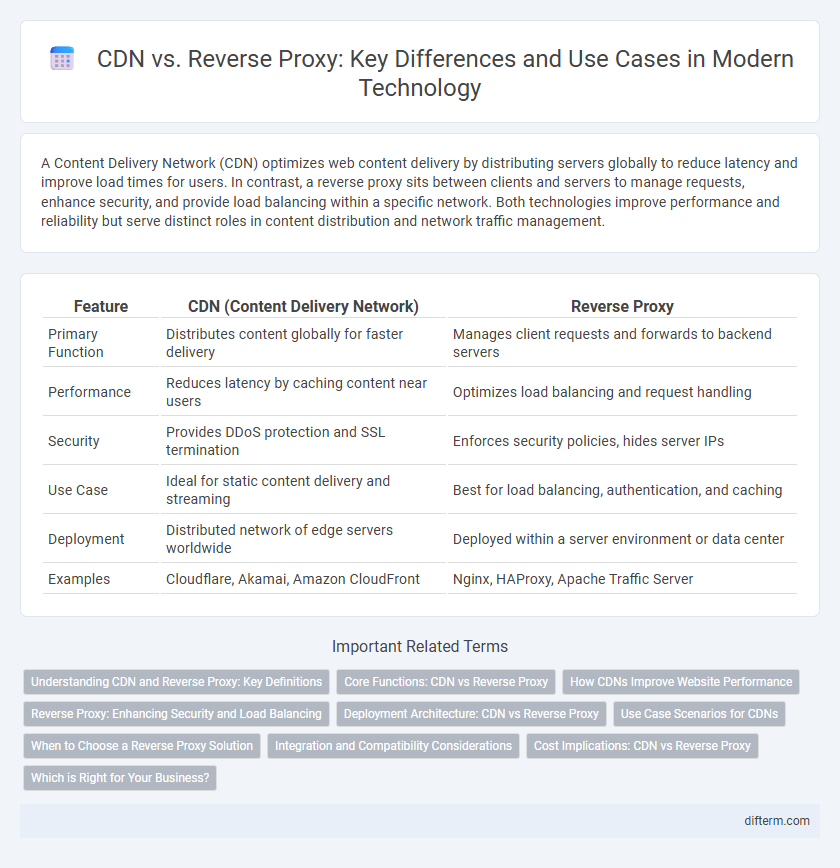A Content Delivery Network (CDN) optimizes web content delivery by distributing servers globally to reduce latency and improve load times for users. In contrast, a reverse proxy sits between clients and servers to manage requests, enhance security, and provide load balancing within a specific network. Both technologies improve performance and reliability but serve distinct roles in content distribution and network traffic management.
Table of Comparison
| Feature | CDN (Content Delivery Network) | Reverse Proxy |
|---|---|---|
| Primary Function | Distributes content globally for faster delivery | Manages client requests and forwards to backend servers |
| Performance | Reduces latency by caching content near users | Optimizes load balancing and request handling |
| Security | Provides DDoS protection and SSL termination | Enforces security policies, hides server IPs |
| Use Case | Ideal for static content delivery and streaming | Best for load balancing, authentication, and caching |
| Deployment | Distributed network of edge servers worldwide | Deployed within a server environment or data center |
| Examples | Cloudflare, Akamai, Amazon CloudFront | Nginx, HAProxy, Apache Traffic Server |
Understanding CDN and Reverse Proxy: Key Definitions
A Content Delivery Network (CDN) is a distributed network of servers that delivers web content to users based on their geographic location, improving load times and reducing latency. A reverse proxy acts as an intermediary for requests from clients seeking resources from servers, enhancing security, load balancing, and caching. Both technologies optimize web performance but serve distinct roles: CDNs focus on global content distribution, while reverse proxies manage internal traffic routing and server protection.
Core Functions: CDN vs Reverse Proxy
Content Delivery Networks (CDNs) primarily optimize web performance by distributing content across multiple geographically dispersed servers, reducing latency and improving load times for end-users. Reverse proxies serve as intermediaries between clients and backend servers, managing traffic by providing load balancing, security, and caching to protect and streamline server operations. While CDNs focus on content distribution and acceleration, reverse proxies emphasize request management and server optimization.
How CDNs Improve Website Performance
Content Delivery Networks (CDNs) improve website performance by distributing web content across multiple geographically dispersed servers, reducing latency and load times for users worldwide. By caching static assets such as images, scripts, and stylesheets closer to the end user, CDNs decrease the distance data must travel, optimizing bandwidth usage and decreasing server load. This results in faster page load speeds, improved user experience, and enhanced scalability during traffic spikes.
Reverse Proxy: Enhancing Security and Load Balancing
Reverse proxies act as intermediaries between clients and servers, enhancing security by masking the origin server's IP address and filtering malicious traffic. They optimize load balancing by distributing incoming requests evenly across multiple backend servers, preventing overloads and improving application availability. This approach also provides centralized logging and SSL termination, further strengthening security and simplifying certificate management.
Deployment Architecture: CDN vs Reverse Proxy
Content Delivery Networks (CDNs) deploy a distributed architecture with multiple edge servers globally positioned to cache and deliver content closer to end-users, enhancing latency and reliability. Reverse proxies operate as intermediary servers within a centralized network infrastructure, managing incoming client requests and balancing loads across backend servers to optimize resource utilization and security. The CDN's globally dispersed nodes contrast with the reverse proxy's localized position, directly impacting scalability, fault tolerance, and deployment complexity in web infrastructure.
Use Case Scenarios for CDNs
Content Delivery Networks (CDNs) excel in delivering static assets like images, videos, and scripts across globally distributed edge servers, enhancing website speed and reliability for users worldwide. They are ideal for high-traffic websites, streaming services, and e-commerce platforms requiring reduced latency and load balancing during traffic spikes. Compared to reverse proxies, CDNs specialize in caching content closer to end users, optimizing performance and scalability, while reverse proxies primarily handle internal request routing and security within a data center.
When to Choose a Reverse Proxy Solution
Choose a reverse proxy solution when you need advanced load balancing, enhanced security features like SSL termination, and seamless integration with backend servers for improved scalability. Reverse proxies effectively manage traffic distribution across multiple servers, reduce server load, and provide caching to speed up response times. They are ideal for complex web architectures requiring fine-grained control over request routing and protection against DDoS attacks.
Integration and Compatibility Considerations
CDN integration requires seamless compatibility with existing DNS and SSL configurations, ensuring efficient content delivery across diverse geographic locations without altering origin server settings. Reverse proxy compatibility hinges on its ability to interface smoothly with backend servers, supporting protocols like HTTP/2 and WebSocket to optimize request routing and load balancing. Both solutions demand careful alignment with security policies and infrastructure to avoid conflicts and maintain performance integrity.
Cost Implications: CDN vs Reverse Proxy
CDNs typically incur higher costs due to extensive global server networks and bandwidth usage, while reverse proxies often involve lower expenses focused on server management and traffic routing within a single infrastructure. Businesses prioritizing scalable content delivery with reduced latency might invest more in CDNs to optimize user experience across diverse geographies. Conversely, reverse proxies serve as cost-effective solutions for load balancing, security, and caching within localized environments, minimizing operational expenditure.
Which is Right for Your Business?
Choosing between a CDN and a reverse proxy depends on your business's need for speed, security, and scalability. A CDN distributes content globally to reduce latency and handle traffic spikes, ideal for businesses with high web traffic and international users. Reverse proxies offer enhanced security features like IP masking and load balancing, making them suitable for companies prioritizing server protection and resource management.
CDN vs Reverse proxy Infographic

 difterm.com
difterm.com